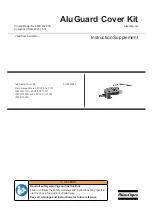
Art. No. DS 4092 TS
Signalling of a warning/ring tone
The device enables the signalling of a warning/ring tone in addition to acknowledgement or
status signalling. The warning/ring tone is activated by a separate 1-bit communication object.
As soon as a "1"-telegram is received via the object "warning tone/ring tone", the buzzer outputs
a single tone. The signal duration can be configured in the ETS. The tone can also be switched
off before the signal duration has elapsed by receiving a "0" telegram via the object.
Each "1" telegram retriggers the tone output. Thus, the signal duration is retriggered as a result.
The volume of the warning/ring tone can be differentiated into two settings (volume 1, volume 2)
and switched over by a 1-bit communication object during regular operation of the device (see
page 88-89).
i
A warning/ring tone can be combined in the ETS with an acknowledgement signal, or
alternatively, with a telegram acknowledgment. In this case, the warning/ring tone has a
higher priority.
Function-dependent signals
Function-dependent signals have the lowest priority. These signals are function-dependent
because, firstly, they are configured alternatively in the ETS (acknowledgement signalling,
telegram acknowledgement, status signalling), and secondly, are also executed automatically
by operating functions (signal on saving a scene, signal on value adjustment). The signals of
the operating functions are only executed, however, if the signalling function of the buzzer is
configured in the ETS to "acknowledgement signalling". The buzzer then reacts similarly to
operations of the rotary knob or push-button.
When the buzzer works as acknowledgement signalling, it outputs a single tone with an
adjustable signal duration during an operation of the rotary knob or push-button. In addition, a
signal occurs when a storage telegram is transmitted in the function "Scene extension" or when
a telegram is transmitted for the value adjustment in the function "value transmitter". The signal
duration of the acknowledgement signalling can be set in the ETS. In contrast to this, the signal
duration of the signalling for a storage telegram (2 seconds) and the value adjustment (250
milliseconds) is permanently defined.
Alternatively, the telegram acknowledgment can be configured for acknowledgement signalling.
The telegram acknowledgment only signals the transmission of telegrams in the function
"2-channel operation" (signal duration 250 milliseconds), the transmission of a scene storage
telegram or the transmission of telegrams for value adjustment (not with "Value transmitter
comfort 0…255") in the described signal lengths. Other operations of the rotary knob or push-
button are not signalled after the telegram acknowledgement.
As a further alternative to acknowledgement signalling or telegram acknowledgment, it is
possible to activate the buzzer as status signalling via a communication object of its own. During
the status signalling, it is possible to distinguish whether the buzzer outputs a single tone or
pulsating tone at a frequency of approx. 1 Hz by means of a parameter setting in the ETS. In
both cases, the signal duration can be set in the ETS.
As soon as the device receives a "1"-telegram via the status object of the buzzer, the buzzer
outputs the configured tone for the preset signal duration. The tone can also be switched off
before the signal duration has elapsed by receiving a "0" telegram via the status object.
Each "1" telegram retriggers the tone output. Thus, the signal duration is retriggered as a result.
i
An acknowledgement signal, or alternatively, a telegram acknowledgment, can be
combined optionally in the ETS with the signalling of a warning/ring tone. In this case, the
warning/ring tone has a higher priority.
Buzzer volume
The buzzer can output signal tones at different volumes. Depending on the signalling function,
the volume is either preset or is configurable at up to three different volume levels in the ETS
(see table below).
Page 88 of 143
Software "Rotary sensor with extensions 10FE1x"
Functional description















































